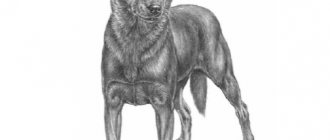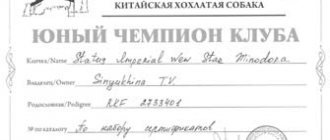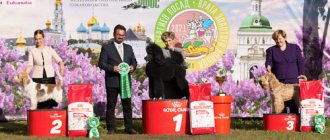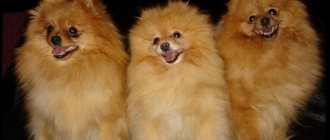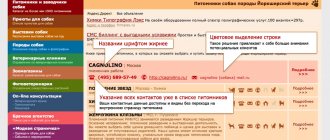Exhibition classes.
| Class | Age | Note | |
| Baby | Baby | 3-6 months | |
| Puppies | Puppy | 6-9 months | |
| Juniors | Junior | 9-18 months | |
| Intermediate | Intermediate | 15-24 months | |
| Open | Open | from 15 months | |
| Worker | Working | from 15 months | For dogs that have working diplomas in a specialized type of test (when registering for CACIB rank shows, only international certificates are taken into account); |
| Champions | Champion | from 15 months | for dogs with:
|
| Winners | Winner | from 15 months | Only at specialized special breed exhibitions, with CAC, CCC, PC certificates from January 1, 2022 the class is absent. |
| National Club Champions | Champion Club | from 15 months | Only at specialized special breed shows, if you have the CH Club title (National Club Champion) |
| Veterans | Veteran | from 8 years old | |
Winners are often awarded a rosette or trophy.
The date for determining the dog's age is the day of the exhibition. If the dog's birthday coincides with the date of the exhibition, then the owner has the right to independently decide in which class to register the dog.
Dog classes by age
Pet class in a dog: what is it, what does breeding mean?
Depending on the age of the animal when registering at the exhibition, it can be enrolled in the following exhibition classes:
- from 4 to 6 months – baby class;
- from 6 to 9 months – puppy class;
- from 9 to 18 months – junior class;
- intermediate class in dogs (also called young class) from 15 to 24 months;
- open class starting from 15 months;
- from 15 months, winner class, but provided that the pet has certificates of a certain rank;
- Veteran class is available starting from 8 years old.
It must be taken into account that the dog’s age is determined on the day preceding the start day of the event.
Dog classes by age
Important! Classes are divided not only by age, but also by gender.
Ratings
- In the junior, intermediate, open, working, champion and veteran classes, as well as in the National Club Champion class (at special breed shows), the following marks are awarded: excellent / excellent (red ribbon), can only be awarded to a dog very close to the ideal of the standard presented in excellent condition, demonstrating a harmonious, balanced temperament, having a high class and excellent training; its excellent characteristics, fully consistent with the breed, allow us to ignore some imperfections, however, sexual dimorphism must be clearly expressed;
- very good / very good (blue ribbon), can only be awarded to a dog that has the typical characteristics of the breed, well-balanced proportions and is presented in correct condition; a few minor faults are allowed, but the dog must nevertheless demonstrate class;
- good / good (green ribbon), should be awarded to a dog that has the main characteristics of the breed; the advantages must outweigh the disadvantages, so that the dog can still be considered a good representative of its breed;
- satisfactory (yellow ribbon), should be awarded to a dog that can be undoubtedly classified as a particular breed without possessing its main advantages, as well as to a dog whose physical condition differs sharply from the desired one;
- disqualification / disqualification (white ribbon) should be given to the dog in the following cases: the type does not correspond to the standard, unusual or aggressive behavior, cryptorchidism, defects of the dental system, defects in the structure of the jaws, non-standard color or structure of the coat, obvious signs of albinism, any disqualifying defect, provided for by the standard of this breed, as well as defects that threaten health; the reason for disqualification must be reflected in the description and in the report; description sheets (original and copy) must be certified by the judge’s handwritten signature and the signature of the owner/handler of the disqualified dog, confirming that he was familiar with the fact and reason for the disqualification;
- impossible to judge (without evaluation), given to a dog if it continuously jumps or rushes out of the ring, making it impossible to evaluate movements and gait, or does not allow the judge to feel himself, examine his teeth and bite, anatomy and structure, tail or testes, or she shows signs of surgery or treatment intended to mislead the judge, disguise or correct defects in the exterior (for example, an eyelid, ear, tail has been corrected); the same decision must be made in case of double handling (attracting the dog's attention from outside the ring), which is strictly prohibited at all shows in the FCI system; the reason for leaving without assessment must be reflected in the description and in the report.
- very promising / very promising (red ribbon);
Show class for dogs: pros, cons, who is suitable for them
Show puppies are characterized by ideal compliance with the standard. Such babies are born very rarely, which explains their impressive cost. They are obtained either from the same parents, or from four-legged breeding class.
Breeders do not always offer elite animals for sale. They often keep them for themselves to produce new high-quality offspring. Such pets can be sold even more expensive due to their good pedigree.
The advantages of show class include:
- maximum compliance with the standard;
- presentable appearance;
- the possibility of creating a profitable breeding business (high probability of giving birth to high-quality puppies);
- advantage over other competitors in dog shows (show pets often take prizes).
The main disadvantage is the high price. Not every owner can buy an elite animal. This class also has several other disadvantages:
- long waits and serious checks (the queue at prestigious nurseries is scheduled several years in advance, and future owners are asked for recommendations);
- possible problems with the nervous system (found in dogs from breeders who focus exclusively on ideal conformation);
- frequent congenital pathologies (arise due to inbreeding).
Show puppies are suitable for owners planning to engage in further breeding or a show career. Please note that in the latter case, getting the champion title is not so easy. In addition to appearance, you will need to monitor the quality and regularity of training.
Certificates and titles
In the ring, at the discretion of the judge, certificates may be issued and titles awarded:
| Baby | Puppies | Juniors | The promenade is terrible | Open | Worker | Champions | National Club Champions | Veterans |
| CW | ||||||||
| JCAC | ||||||||
| R.J.C.A.C. | ||||||||
| CAC | ||||||||
| R.CAC | ||||||||
| CACIB | ||||||||
| R.CACIB | ||||||||
| VCAC | ||||||||
| R.VCAC | ||||||||
| YuChRKF | ||||||||
| CHRKF | ||||||||
| VChRKF | ||||||||
| YuChF | ||||||||
| Black Sea Fleet | ||||||||
| VChF | ||||||||
| PC | ||||||||
| YuPK | ||||||||
| Military-industrial complex | ||||||||
| KCHK | ||||||||
| YKCHK | ||||||||
| VKCHK | ||||||||
| SS | ||||||||
| USS | ||||||||
| VSS | ||||||||
| PP | ||||||||
| UPP | ||||||||
| runway | ||||||||
| KChP | ||||||||
| SKChP | ||||||||
| VKChP |
Exhibition-certificate.
This table makes it possible to see at what rank exhibitions (CAC, CRF, Black Sea Fleet, CACIB) you can get this or that certificate.
| Black Sea Fleet | CHRKF | CACIB | ||||||
| BOS | CW | JBOB | BOS | CW | JBOB | BOS | CW | JBOB |
| CACIB | ||||||||
| CAC | ||||||||
| Black Sea Fleet | ||||||||
| CHRKF | ||||||||
| JCAC | ||||||||
| YuChF | ||||||||
| YuChRKF | ||||||||
BOS - Best male, best female
CW - Class Winner
JBOB - Junior class winner.
* For the decoding of certificates (CAC, Black Sea Fleet, ChRKF, JCAC, etc.), see the next section.
** VRKF Certificates (RKF Veteran Champion), VCAC, etc. are awarded similarly to Junior certificates.
*** Exhibitions whose rank is designated CAC gr [n] are held only for dogs of the designated group, certificates are awarded as for an exhibition of the Black Sea Fleet rank.
Decryption of certificates.
CW is the class winner. Awarded at a show of any rank to the first dog in the class that receives the highest rating.
JCAC is a candidate for young champions of Russia in beauty. Assigned at CACIB and CAC rank exhibitions to a male and female who received CW in the junior class.
R.JCAC is a reserve candidate for the young champions of Russia in beauty. Can be assigned CACIB and CAC rank at shows to a dog that has received an “excellent 2” rating in the junior class (provided that the first dog is awarded JCAC). If CAC is assigned to a dog that has the title of Russian Junior Champion, R.JCAC is counted as JCAC. In addition, when claiming the title of Russian junior champion, 2 x R.JCAC can be counted as 1 x JCAC (one time).
CAC is a candidate for Russian beauty champion. At shows, the CACIB rank is assigned to all dogs that received CW in the intermediate, open, working, and champion classes; at exhibitions, the CAC rank is assigned to the male and female who took first place in the comparison of CW classes of intermediate, open, working, and champions.
R.CAC is a reserve candidate for Russian beauty champion. At shows, the CACIB rank can be assigned to dogs that have received an “excellent 2” rating in the intermediate, open, working, champion classes (provided that the first dog is awarded CAC); at shows, the CAC rank is assigned by comparing the CW classes of intermediate, open, working, champions remaining after choosing the CAC owner, and the second dog from the class whose CW received CAC. If CAC is assigned to a dog that has the title of Russian Champion, R.CAC is counted as CAC. In addition, when claiming the Russian champion title, 2 x R.CAC can be counted as 1 x CAC (one time).
CACIB is a candidate for international beauty champion. Assigned only at CACIB rank shows to the male and female who took first place in the comparison of CW classes of intermediate, open, working, champions.
R.CACIB – reserve candidate for international beauty champions. Assigned only at shows of the CACIB rank in comparison of the CW remaining after the selection of the CACIB owner and the dog that received “excellent 2” in the class whose winner was awarded CACIB.
VCAC is a candidate for veteran champion of Russia in beauty. Assigned at CACIB and CAC rank exhibitions to a male and female who received CW in the veteran class.
R.VCAC is a reserve candidate for veteran champions of Russia in beauty. Can be assigned at CACIB and CAC rank shows to a dog that has received an “excellent 2” rating in the veteran class (provided that the first dog is awarded VCAC). If VCAC is assigned to a dog who has the title of Russian Veteran Champion, R.VCAC is counted as VCAC. In addition, when claiming the title of Russian Veteran Champion, 2 x R.VCAC can be counted as 1 x VCAC (one time)
YuChRKF – young champion of the RKF. Assigned at shows of the CACIB rank and at shows of the CAC / “RKF Champion” rank to a male and female who received JCAC.
ChRKF is the champion of the RKF. At shows, the CACIB rank is assigned to a male and female who received a CACIB; at exhibitions the rank CAC / “Champion of the RKF” is assigned to the male and female who received CAC.
VChRKF - veteran champion of the RKF. Assigned at shows of the CACIB rank and at shows of the CAC / “RKF Champion” rank to a male and female who received VCAC.
YuChF is the young champion of the federation. Assigned at exhibitions the rank CAC / “Federation Champion” to a male and female who received JCAC.
The Black Sea Fleet is the champion of the federation. At shows, the rank CAC / “RKF Champion” is assigned to all dogs that received CW in the intermediate, open, working, champion classes; at shows, the rank CAC / “Federation Champion” is assigned to a male and female who received CAC.
VChF is a veteran champion of the federation. Assigned at exhibitions the rank CAC / “Federation Champion” to a male and female who received VCAC.
PC [year] – winner of the National Club of the Year. Awarded at the annual national monobreed show in breeds that have a National Club Class, a male and a female who took first place in the comparison of CW classes of intermediate, open, working, champions and National Club Champions (from 01/01/2020).
JPK [year] – young winner of the National Club of the Year. Assigned at the annual national monobreed show in breeds that have a national standard, to a male and female who received CW in the junior class (from 01/01/2020).
VPK [year] – veteran winner of the NKP of the year. Assigned at the annual national monobreed show in breeds that have a national standard, to a male and female who received CW in the veteran class (from 01/01/2020).
KCHK is a candidate for NKP champion. Assigned in breeds that have a national code:
- at the annual national special breed show of the “Club Winner” rank - to all dogs that received CW in the intermediate, open, working, champion classes (in the NCP champion class, the CCC is not awarded);
- at single-breed exhibitions of the CCC rank - for a male and a female who took first place in the comparison of CW classes of intermediate, open, working, champions (CW class of NKP champions does not participate in the comparison at the CCC);
- in specialized breed rings within the framework of exhibitions of the CACIB rank - for a male and female who received CACIB;
- in specialized breed rings within the framework of exhibitions of the CAC rank for the corresponding group of breeds - male and female who received CAC.
YKCHK is a candidate for young club champions. Assigned in breeds that have a National Standard: at single-breed exhibitions of the CCC rank, in specialized breed rings within the framework of exhibitions of the CACIB rank and in specialized breed rings within the framework of exhibitions of the CAC rank for the corresponding group of breeds - male and female, who received CW in the junior class.
VKCHK is a candidate for veteran champion of the club. Assigned in breeds that have NCP: at single-breed exhibitions of the CCC rank, in specialized breed rings within the framework of exhibitions of the CACIB rank and in specialized breed rings within the framework of exhibitions of the CAC rank for the corresponding group of breeds - male and female, who received CW in the veteran class.
PP [year] – winner of the breed of the year. Awarded at the annual National Specialty Show in breeds that do not have a breed code, to the male and female who took first place in the comparison of CW classes of intermediate, open, working, and champions.
JPP [year] – young winner of the breed of the year. Assigned at the annual National Specialty Show in breeds that do not have a breed code, to a male and female who received CW in the junior class.
VPP [year] – veteran winner of the breed of the year. Assigned at the annual National Specialty Show in breeds that do not have a breed code, to a male and female who received CW in the veteran class.
KChP is a candidate for champion of the breed. Assigned in breeds that do not have a national code: at the annual national specialized exhibition of the rank “Breed Winner” - to all dogs that received CW in the intermediate, open, working, champion classes; in specialized breed rings within the framework of exhibitions of the CACIB rank - for a male and female who received CACIB; in specialized breed rings within the framework of exhibitions of the CAC rank for the corresponding group of breeds - male and female who received CAC.
YKChP – candidate for young champion of the breed. Assigned in breeds that do not have a national code: at an annual national specialized exhibition, in specialized breed rings within the framework of exhibitions of the CACIB rank and in specialized breed rings within the framework of exhibitions of the CAC rank for the corresponding group of breeds - male and female, who received CW in the junior class.
VKChP – candidate for veteran champion of the breed. Assigned in breeds that do not have a national code: at an annual national specialized exhibition, in specialized breed rings within the framework of exhibitions of the CACIB rank and in specialized breed rings within the framework of exhibitions of the CAC rank for the corresponding group of breeds - male and female, who received CW in the veteran class.
СС – certificate of conformity. Assigned only at single-breed exhibitions: at a national single-breed exhibition of the rank “Club Winner” / “Breed Winner” - to dogs that received the rating “excellent 2” in the intermediate, open, working, champion classes (provided that the first dog was awarded CCC/CCP) ; at exhibitions, the CCC rank in breeds that have a National Club Award is assigned by comparing the CW classes of intermediate, open, working, champions remaining after the selection of the CCC holder, and the second dog from the class whose CW received the CCC. When registering the title of National Club Champion / Breed Champion, 3 x CC can be counted as 1 x CCC / CCC (one time).
YUSS – certificate of conformity in the junior class. Assigned only at single-breed exhibitions to dogs that received the rating “excellent 2” in the junior class (provided that the first dog was awarded JCC/JCCCH). When registering the title of junior champion of the National Club / junior champion of the breed, 3 x JCC can be counted as 1 x JCC/JUCCHP (one time).
ВСС – certificate of conformity in the veteran class. Assigned only at single-breed shows to dogs that have received the rating “excellent 2” in the veteran class (provided that the first dog was awarded the VKCHK/VKChP). When registering the title of Veteran National Club Champion / Veteran Breed Champion, 3 x BCC can be counted as 1 x VKCHK / VKChP (one time).
- At all RKF and FCI exhibitions, the awarding of titles and certificates (including reserve ones) is the prerogative of the judge.
- The award of a CAC certificate at a show of any rank must imply that the dog corresponds to the level of a champion - both national and international.
- At international shows, if a breed has been awarded at least one CAC certificate, refusal to award CACIB is not the norm and must be convincingly motivated.
- No reserve certificate can be awarded unless a primary certificate has been awarded.
At exhibitions of all ranks in each breed the following are also selected:
- LB / BOB baby – best baby of the breed; selected by comparing a male and a female CW baby (at shows where, by decision of the organizing committee, enrollment in the baby class was carried out).
- BOB puppy – best puppy of the breed; selected by comparing male and female CW puppies.
- Best Junior / BOB junior – best junior of breed; selected by comparing male and female CW junior class.
- LV / BOB veteran – best veteran of the breed; selected by comparing a male and a female CW veteran class.
- BOB / BOB (Best of Breed) – best representative of the breed; selected by comparing six dogs: a male and a female CW junior class; male and female selected by comparison of CW classes Intermediate, Open, Working, Champions and (if applicable) National Club Champions; males and females CW veteran class.
- BOS (Best of Opposite Sex) – the best representative of the opposite sex in the breed; selected by comparing dogs of the opposite sex after selecting BOB/BOB.
Bitch and male - holders of the main titles are selected after the completion of judging of adult classes. PB, BOS, BJ, BO, BOB and BOS are selected after the end of the breed judging.
Dog show ranks: transcript
Similar ranks are indicated in official documents of the Russian Canine Federation:
- Rank CACIB – International, in accordance with the RKF calendar plan.
- CAC rank – all breeds, in accordance with the RKF calendar plan.
Inexperienced dog breeders use the term “CAC”, which is not correct.
Exhibitions of CAC rank are divided into:
- CAC Champion RKF;
- CAC Federation Champion;
- CAC Candidate for Federation Champion.
Only dog breeds recognized by the FCI are allowed to participate in International Exhibitions of the CACIB rank.
Dog breeds recognized by the FCI and the RKF are allowed to participate in exhibitions of all breeds of the CAC rank.
The organizers of the exhibition must be sure that the dogs declared in the catalog are registered in the Pedigree Book of the country - a member of the FCI or AKC (American Kennel Club) - USA, KS - (English Kennel Club) Great Britain, SKS - (Canadian Kennel Club) Canada.
At all certificate shows, a ring can be organized for dogs that require a judge's description (without assigning titles or certificates).
